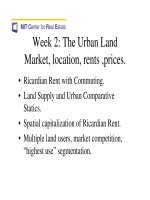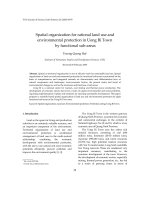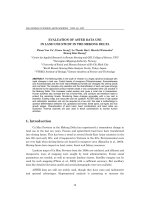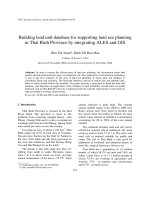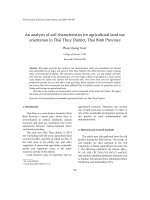Slide land use planing
Bạn đang xem bản rút gọn của tài liệu. Xem và tải ngay bản đầy đủ của tài liệu tại đây (242.56 KB, 25 trang )
LAND USE PLANNING(FAO)
CONCERN ABOUT
What is the land use planning?
The goal of Land use planning
Steps in land use planning?
Planning at different levels
What is the land use planning?
Land use planning (LUP) is defined
as
"a systematic
assessment of land and water potential, alternative patterns
of land use and other physical, social and economic
conditions, for the purpose of selecting and adopting land-use
options which are most beneficial to land users."
Planning at 03 different levels
Land-use planning can be applied at three broad levels:
National level: Planning is concerned with national goals and
the allocation of resources.
District level: Development projects are often at this level.
Local level : The local planning unit may be the village, a group of
villages.
Map scale
1 : 100000 or 1: 5000000
1 : 250000 or 1: 50000
1 : 20000 or 1: 5000
The time of land use planning (timeframe)
Short term planning
Medium term planning
< 1 year
Long term planning
Long term strategic planning
5-10
1 - 5 years
years
Up to 30 years (up to 50 years for large scale cases)
Land Use Planning
Objectives
The objectives are targeted at a balanced development
in principle are influenced by three elements:
Society
Economy
Environment
Land use process steps - FAO
Step 1. Establish goals and terms of reference
Step 2. Organize the work
Step 3. Analyze the problems
Step 4. Identify opportunities for change
Step 5. Evaluate land suitability
Step 6. Appraise the alternatives: environmental, economic and social analysis
Step 7. Choose the best option
Step 8. Prepare the land-use plan
Step 9. Implement the plan
Step 10. Monitor and revise the plan
1 - GOALS AND TERMS OF REFERENCE
• Define the planning area.
• Contact the people involved.
• Basic information: land resources / present land use/ infrastructure /
population
• Make a preliminary identification of problems and opportunities.
• Establish the criteria for making decisions on land use.
• Set the scope of the plan / Set the planning period.
2 - ORGANIZATION OF THE WORK
List the planning tasks and activities.
- identify the people and organizations responsible for or
contributing to it;
- set out the resources needed;
-estimate the time needed.
- Use of maps, air photographs and computers.
- Budget for staff, equipment and transport costs.
- Provide for: • transport (vehicles, spares, fuel, servicing)•
equipment; • office facilities.
3- ANALYSIS OF PROBLEMS
• Collect data on the existing situation; where possible, compile
maps:
(Population/ and resources/ employment and income/ present land
use/ production and trends/ infrastructure)
• Sources: maps, satellite imagery, air photographs, Check in the
field.
• Identify and map: land units / land-use systems.
• Identify problems of land use: nature and severity, land units and
land-use systems affected; analysis of causes.
Methods: interviews with land users, local leaders, extension
staff, agencies; field reconnaissance.
4- IDENTIFICATION OF OPPORTUNITIES FOR CHANGE
- Opportunities: the people, land resources, improved technology,
economic measures, government action;
-Land-use strategies: no change, maximum production, minimum
investment, maximum conservation, maximum equity;
5- LAND SUITABILITY EVALUATION
• Describe land-use types and Select land qualities and land
characteristics.
• Map the land units and determine their relevant land
characteristics and qualities.
• Set limiting values to land-use requirements, to be used for
determining class limits for land suitability.
• Match land use with land:
• Map land suitability for each land-use type.
6 APPRAISAL OF ALTERNATIVES: ENVIRONMENTAL,
ECONOMIC AND SOCIAL ANALYSIS
- Environmental impact assessment: soil and water resources, forest
resources, wildlife conservation, resources for tourism and
recreation; off-site effects.
-Financial analysis: are the proposed land-use types profitable for
the farmer or other land users?
-- Social impact: what effects will the proposed changes have on
different sections of the community, especially women, minority
groups and the poor?
7 CHOICE OF THE BEST OPTION
• Set out a series of options and recommendation for land-use
types to land units.
The evaluation in terms of land suitability and environmental,
economic and social analysis.
• Set out the consequences of these options in terms of the goals
and planning objectives.
PREPARATION OF THE PLAN
• Prepare maps - the basic or master land-use plan and supporting
maps.
• Set out the land-use allocations and recommendations. Give
descriptions of land-use types, including management
recommendations on each kind of land.
• Set targets for achievement, by land-use type, area and agency.
• Determine the finance needed for each operation and determine
sources of funds.
• Write the report - executive summary, main report, maps and
appendixes.
10 MONITORING AND REVISION
• List the goals and criteria achievement agreed in Step 1. Add
any that emerged later in the planning period.
• Gather data relevant to each criterion of attainment: physical,
economic and social.
• Compare what has been achieved with what was planned.
Identify elements of success and failure.
• Seek explanations for failures. Were they caused by:
• Review the goals: are they still valid?
• Initiate modification or revision of the plan:
The steps can be grouped into the following logical sequence:
Step 1. Establish goals and terms of reference
Step 2. Organize the work
Step 3. Analyze the problems
• Identify the problems.
Step 4. Identify opportunities for change
Step 5. Evaluate land suitability
Step 6. Appraise the alternatives:
environmental, economic and social analysis
• Determine what
alternative solutions
exist.
Step 7. Choose the best option
Step 8. Prepare the land-use plan
Step 9. Implement the plan
Step 10. Monitor and revise the plan
• Decide which is the best
alternative and prepare the plan.
• Put the plan into action, see
how it works and learn from
this experience.
Ex - Choose the correct word to fill in each gap in the following passage.
In
Depend on
applied
Remains
That
Creating convenient
For
Efficiency
Planning
………..the United States, the terms land-use………….., regional planning, urban
planning, and urban design are often used interchangeably, and will…..……the country
and project in question. Despite confusing nomenclature, the essential function of landuse planning ……….the same whatever term is………. The Canadian Institute of
Planners offers a definition………..land-use planning means the scientific, aesthetic, and
orderly disposition of land, resources, facilities and services with a view to securing the
physical, economic and social………...., health and well-being of urban and rural
communities. The American Planning Association states that the goal of land-use
planning is to further the welfare of people and their communities by…. …………,
equitable, healthful, efficient, and attractive environments…………… present and future
generations.
TRANSLATE IN TO VIETNAMESE - 1
Land is not the same everywhere. Land is, self-evidently, the other
focus of land use planning. Capital, labor, management skills and
technology can be moved to where they are needed. Land cannot be
moved, and different areas present different opportunities and
different management problems. Nor are land resources unchanging:
this is obvious in the case of climate and vegetation, but examples
such as the depletion of water resources or the loss of soil by erosion
or salinity are reminders that resources can be degraded, in some
cases irreversibly. Good information about land resources is thus
essential to land-use planning.
TRANSLATE IN TO VIETNAMESE - 2
Establish goals and terms of reference. Ascertain the present
situation; find out the needs of the people and of the government;
decide on the land area to be covered; agree on the broad goals and
specific objectives of the plan; settle the terms of reference for the
plan.
Analyze the problems. Study the existing land-use situation,
including in the field; talk to the land users and find out their needs
and views; identify the problems and analyze their causes; identify
constraints to change.
ANSWER
In the United States, the terms land-use planning, regional planning, urban
planning, and urban design are often used interchangeably, and will depend on
the country and project in question. Despite confusing nomenclature, the
essential function of land-use planning remains the same whatever term is
applied. The Canadian Institute of Planners offers a definition that land-use
planning means the scientific, aesthetic, and orderly disposition of land,
resources, facilities and services with a view to securing the physical,
economic and social efficiency, health and well-being of urban and rural
communities. The American Planning Association states that the goal of landuse planning is to further the welfare of people and their communities by
creating convenient, equitable, healthful, efficient, and attractive environments
for present and future generations.
TRANSLATE IN TO VIETNAMESE - 2
In the socio-economic assessment, LUTs’ socio-economic indicators were evaluated
for each LMU. The socio-economic indicators that applied in this study were: gross
income, investment costs, variable costs, total costs, benefit/cost ratio, labor days,
accessibility, and financial risk. Values of socio-economic indicators are called
socio-economic scores
In the environmental assessment, the LUTs’ impacts on the surrounding environment
were estimated on the basis of the impact of six environmental indicators on the land.
The six indicators were sedimentation, salinization, groundwater use, water pollution
with organic wastes and nutrients, use of fertilizer and chemicals and terrain
adjustments. The degree of environmental impact of each indicator is determined from
the results of the farmer interviews, expert knowledge, and literature research.
land use types’ (LUT)
land-mapping units (LMU)
ANSWER 1
Đất đai thì không giống nhau ở mọi nơi. Đất đai, bản thân nó đã là tiêu điểm
trong quy hoạch sử dụng đất đai. Vốn, lao động, kỷ năng quản lý và kỷ thuật
có thể đưa đi đến nơi nào cần đến. Nhưng đất đai không thể di chuyển được,
và cho thấy những vùng đất khác nhau thì cho những khả năng khác nhau và
những vấn đề quản lý cũng khác nhau. Không phải nguồn tài nguyên đất đai là
không thay đổi, điều này khá rõ ràng trong trường hợp của khí hậu và thực
vật, các trường hợp khác như sự thiếu hụt nguồn nước hay sự mất đất gây ra
do xoái mòn hay sự nhiễm mặn thì cũng chỉ cho thấy rõ rằng là nguồn tài
nguyên đang bị suy thoái. Những thông tin đầy đủ về hiện trạng của nguồn tài
nguyên đất đai rất cần thiết cho quy hoạch sử dụng đất đai.
ANSWER
Thiết lập mục tiêu và các tư liệu có liên quan.Trong tình trạng
hiện tại cụ thể tìm ra những nhu cầu của người dân và nhà nước;
quyết định trên vùng đất quy hoạch, diện tích cần thực hiện;
những sự thống nhất nhau về mục tiêu chung và riêng của quy
hoạch; sắp đặt các tư liệu liên quan trong quy hoạch.
Phân tích vấn đề Nghiên cứu tình trạng sử dụng đất đai hiện tại,
bao gồm việc khảo sát ngoài đồng; thảo luận và nói chuyện với
người sử dụng đất đai để tìm ra nhu cầu họ đang cần và tầm
nhìn, quan điểm của họ, xác định ra các vấn đề và phân tích
nguyên nhân; xác định các khó khăn tồn tại cần thay đổi.
